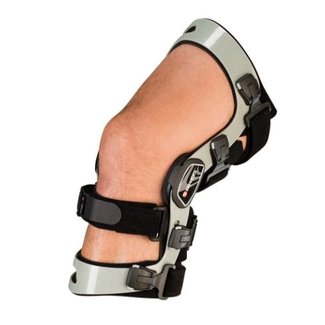Osteoarthritis
Mild Osteoarthritis : Mild OA may involve minor loss of cartilage in the knee joint. Symptoms can include pain, stiffness and tenderness of the knee. Braces may be prescribed to help stabilize the affected area, while reducing pain and increasing confidence during activity.
Moderate Osteoarthritis: In the moderate stage of osteoarthritis, symptoms may include pain, stiffness and tenderness of the knee as well as localized swelling after extended periods of use. Bracing is one method that a Doctor may prescribe to treat this level of osteoarthritis with the goal of limiting pain. This may also help to reduce the rate of progression of arthritis in the knee.
Severe Osteoarthritis: Treatment for severe osteoarthritis often includes surgery. However, for those who have elected against surgery or may have an increased wait before their surgical date, bracing may be a good option. Severe osteoarthritis results in a decrease in synovial fluid and little to no cartilage left in the knee joint, leaving the knee stiff and immobile.
Osgood-Schlatter Disease (OSD)
OSD is inflammation of the patellar ligament at the tibial tuberosity. This can be characterized by a painful bump located below the knee cap, that is worse with activity and better with rest. Common risk factors include sports that involve running and jumping. Treatment can consist of many factors such as icing, stretching and strengthening. However, sometimes the addition of a brace can help apply pressure on the patellar tendon to help relieve tension.
Patellofemoral Pain Syndrome
This can be common in people who participate in running and jumping activities. However, patellar tracking issues may also be caused by other issues including, but not limited to, tendons, ligaments or muscles in the leg that are too tight or too loose, as well as weak thigh muscles. Reduce discomfort caused by maltracking or patellar instability with help from one of our high quality patellofemoral braces. Choose from a wide variety of styles and brands to find the fit that works best for you. These braces are designed to support, align and cushion the knee joint to help the user increase performance or ease tasks of daily living.
Meniscus Injuries
The meniscus is a C-shaped piece of cartilage in the knee that acts as a shock absorber between the shin and thigh bones. A torn meniscus is a common knee injurie as a result of twisting in the knee. This often results in well-localized pain and swelling. The pain is often the worse during twisting and/or squatting motions. Bracing can be an effective way to reduce pain and swelling pre, post or peri-operatively.
Ligament Injuries
Anterior Cruciate Ligament (ACL): The ACL is located in the center of the knee and controls rotation and forward movement of the tibia (shin bone).
Posterior Cruciate Ligament (PCL): The PCL is located in the back of the knee and controls backward movement of the tibia (shin bone).
Medial Collateral Ligament (MCL): The MCL is the ligament that gives stability to the inner knee.
Lateral collateral Ligament (LCL): The LCL is the ligament that gives stability to the outer knee.










